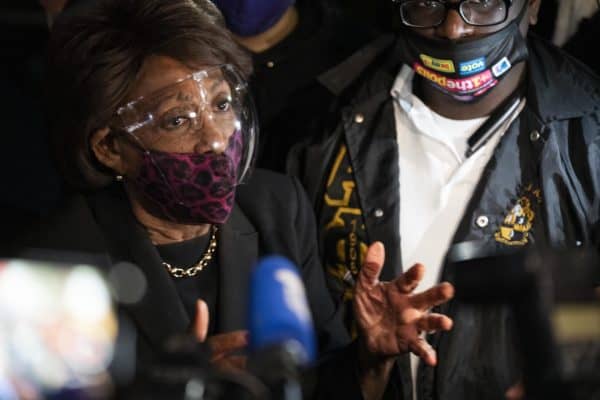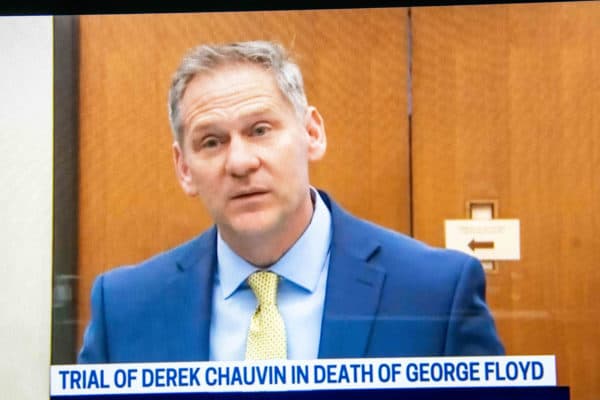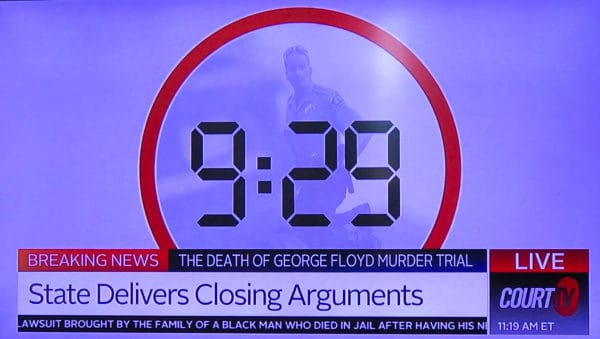The Derek Chauvin Trial — Day 15
Anastasia Katz, American Renaissance, April 20, 2021
Editor’s Note: See our coverage of the first day of the trial here, the second day here, and the third day here, the fourth day here, the fifth day here, the sixth day here, the seventh day here, the eighth day here, the ninth day here, the tenth day here, the eleventh day here, the twelfth day here, the thirteenth day here, and the fourteenth day here.
Over the weekend, before closing arguments, California Congresswoman Maxine Waters flew to Minneapolis to talk to protesters at the courthouse.
“We’ve got to not only stay in the street, but we’ve got to fight for justice. But I am very hopeful and I hope that we’re going to get a verdict that will say, ‘Guilty. Guilty, guilty’. . . . I don’t know whether it’s in the first degree, but as far as I’m concerned, it’s first-degree murder . . . . We’ve got to get more confrontational. We’ve got to make sure that they know that we mean business.”

April 17, 2021, Minnesota: Rep. Maxine Waters (Credit Image: © Dominick Sokotoff/ZUMA Wire)
Derek Chauvin is not even charged with first-degree murder. All three counts are variations of unintentional homicide.
Yesterday, 329 days since George Floyd died, both sides made closing arguments and the jury began deliberations. Judge Peter Cahill started by explaining the law to the jury, saying that it must follow the rule of law even if it thinks the law should be different. He reminded the jury that the defendant is presumed innocent until proven guilty beyond a reasonable doubt; he does not have to prove himself innocent.
The judge defined legal terms and went into detail about what the prosecution needs to prove for Mr. Chauvin to be found guilty of each of the charges.
Prosecutor Steve Schleicher began his closing argument by reviewing witness statements about Floyd’s relationship with his family, and showed photos from his life. Mr. Schleicher also referred to “superhuman strength,” one of the symptoms of excited delirium, a condition Mr. Chauvin and other MPD officers were trained to recognize. One of the other officers mentioned excited delirium while they were restraining Floyd. “There was no superhuman strength that day.” Mr. Schliecher said, “There was no superhuman strength because there’s no such thing as a superhuman. Those exist in comic books.”

Minneapolis Prosecuting Attorney Steve Schleicher. (Credit Image: © Pool Video Via Court Tv via ZUMA Wire)
Mr. Schleicher noted that Floyd had called the defendant “Mr. Officer,” and said that Floyd “pleaded with ‘Mr. Officer.’”
Floyd died with no familiar face to say his final words to, and his final words — “Please, I can’t breathe” — were addressed to Mr. Chauvin. “He asked for help with his very last breath, but Mr. Officer did not help,” he said. “The defendant did not help; he stayed on top of him, continued to push him down, to grind his knees, to twist his fingers into the handcuffs that bound him, looking at him, staring him down at times, and horrified the bystanders who gathered and watched this unfold.”
Mr. Schleicher said he had conducted a “pro-police prosecution,” and was not attacking the noble profession of law enforcement. He called Mr. Chauvin’s actions a “shocking display of abuse of police power,” but added, “This case is called The State of Minnesota versus Derek Chauvin. This case is not called The State of Minnesota versus The Police.”
The prosecutor tried to get inside Derek Chauvin’s mind, showing Exhibit 17, a screenshot of Mr. Chauvin taken by one of the bystanders. He called attention to Mr. Chauvin’s body language and suggested that his pride would not let bystanders tell him what to do. Mr. Chauvin “chose pride over policing.” Recalling how 61-year-old witness Charles McMillian told Floyd that he “couldn’t win,” Mr. Schleicher told the jury, “The defendant was trying to win. . . . He was trying to win, and George Floyd paid with his life.”
Mr. Schleicher went through the body camera footage step by step, beginning with the point of view from Mr. Chauvin’s own camera, when Officers Lane and Kueng were trying to get Floyd into the squad car. “Why was is necessary to shove him in the car?” Mr. Schleicher asked, adding that Police Chief Medaria Arradondo had testified that it is rare to arrest people for counterfeiting.
Showing a slide of the definition of “proof beyond a reasonable doubt,” Mr. Schleicher told the jury that the state does not need to prove its case beyond all doubt, and that it did not need to accept the defense’s “nonsense.”
The prosecutor explained how the case met the requirements for the jury to convict on each charge, and showed a photo of Mr. Chauvin with “9:29” superimposed over him, and a red circle around the image. After hearing Mr. Schleicher repeat “nine minutes and twenty-nine seconds” over and over, this image almost seemed like an advertising logo. By the end of Mr. Schleicher’s closing, he had uttered the phrase “nine minutes and twenty-nine seconds” 17 times.

The prosecution used audio-only clips a few times, and one was particularly deceptive. Floyd very clearly says, “My stomach hurts; my dick hurts,” but the audio was manipulated so that the word “dick” is barely intelligible. The prosecution then misquoted Floyd several times, claiming that he had instead said, “My neck hurts” and “My back hurts.”
Mr. Schleicher concluded with: “It’s what you felt in your gut, it’s what you felt in your heart. This was not policing. This was murder.”
Derek Chauvin took off his face mask in front of the jurors for the first time as defense lawyer Eric Nelson began his closing argument. “You start with the proposition that Mr. Chauvin is innocent of these charges,” Mr. Nelson said. “The state has to advance substantial evidence to convince you that the only doubts that are remaining are unreasonable doubts.”
Throughout the trial, Mr. Nelson stressed that the jury would need to consider the “totality of the circumstances,” and he derided the prosecution’s use of “little snippets . . . a screenshot here, a screenshot there.”
He said, “Lawyers like to present evidence that favors them, but we have to be intellectually honest about the evidence.” He then explained that Dr. David Fowler, a forensic pathologist who testified for the defense, said that carbon monoxide could have contributed to George Floyd’s oxygen deprivation. The next day, the state brought back one of its expert witnesses to tell the jury that this was not possible because Floyd’s oxygen saturation had been 98 percent. (Blood oxygen levels below 80 percent may hurt the brain and heart; the normal range is 95 – 100 percent.) Mr. Nelson said that he could then have stood up and asked, “How could Floyd have been asphyxiated [a key part of the prosecution case], when he had a 98 percent oxygen level?” but that would not have been honest. Mr. Nelson told the jury that Floyd’s blood oxygen level was 98 percent because paramedics and the ER doctor oxygenated his blood when they tried to save him.
“You also can’t prove that there was no carbon monoxide in Floyd’s blood because of this 98 percent figure,” Mr. Nelson said. “The state has failed to meet its burden of proof beyond a reasonable doubt.”
Mr. Nelson later showed how the prosecution, and particularly its expert witness, Dr. Martin Tobin, were biased. The prosecution had shown a screenshot of Floyd’s knuckle against the wheel of the squad car, and Dr. Tobin said that Floyd scraped his knuckle as he used it to push himself up, in order to expand his chest and breathe. Mr. Nelson played the video of that moment, pointing out the time stamp. Floyd’s knuckles were against the car tire when the officers had him in the side-recovery position, shortly after he was on the ground. This position would not have prevented Floyd from expanding his chest.
Mr. Nelson also played the video of the split-second moment when Mr. Chauvin’s toe was off the ground. The prosecution had used a still photo of this moment to hide the fact that it had been so brief. Mr. Nelson told the jury: “You cannot take a single frame and draw conclusions. You have to analyze the totality . . . . Do not let yourself be misled by a single still-frame image.”
The defense’s closing argument revolved around two points: Whether Mr. Chauvin’s actions were an authorized use of force and the cause of George Floyd’s death. If the jury finds that Mr. Chauvin’s actions were authorized, then no crime would was committed. During jury instructions in the morning, Judge Cahill read the following:
No crime is committed if a police officer’s actions were justified by the police officer’s use of reasonable force in the line of duty, in affecting a lawful arrest or preventing an escape from custody. The kind and degree of force the police officer may lawfully use in executing his duty is limited by what a reasonable police officer in the same situation would deem to be necessary. Any use of force beyond that is not reasonable. To determine if the actions of the police officer were reasonable, you must look at those facts which a reasonable officer in the same situation would have known at the precise moment that the officer acted with force. You must decide whether the officer’s actions were objectively reasonable in light of the totality of the facts and circumstances confronting the officer, and without regard to the officer’s own subjective state of mind or intentions or motivations. The defendant is not guilty of a crime if he used force as authorized by law. To prove guilt, the state must prove beyond a reasonable doubt that the defendant’s use of force was not authorized by law.
Mr. Nelson spent a lot of time showing body camera footage to get the jury to see things from Mr. Chauvin’s point of view. Mr. Nelson pointed out that we didn’t have Mr. Chauvin’s own body camera footage because Floyd had knocked both the camera and Mr. Chauvin’s badge off as he fought to stay out of the police car. The video evidence shows that one of the other officers nearly lost his wedding ring.
The defense had proposed all along that George Floyd died of a heart attack. Mr. Nelson reminded the jury that the autopsy contained no report of bruising on Floyd’s neck, back, spinal column, or hypopharynx. He also said that the medical examiner would not have mentioned Floyd’s diseased heart or the presence of drugs in Floyd’s blood if he had not believed that these things contributed to Floyd’s death.
Mr. Nelson went through a timeline of Floyd’s last moments, noting that Floyd went limp only 39 seconds after his last words. Mr. Nelson said that this is inconsistent with low oxygen or strangulation, because people can hold their breaths for 39 seconds without passing out. He said 66 seconds passed between Floyd’s last words and going limp, suggesting a sudden cardiac arrhythmia.
Mr. Nelson concluded: “Human beings make decisions in highly stressful situations that they believe to be right in the very moment it is occurring . . . . There are lots of what-ifs.”
Prosecutor Jerry Blackwell’s long rebuttal repeated much of what Mr. Schleicher had already said. Mr. Blackwell also repeated several times that this was such a commonsense case that a nine-year-old bystander understood it. As he said this, he showed a photo of the girl.
Mr. Blackwell took every chance to paint Mr. Nelson as a liar, making comments such as: “You didn’t get the whole truth.” “The facts have been altered.” “You were told that homicide is a medical term. That’s not what Dr. Baker said.” Mr. Nelson objected when Mr. Blackwell accused him of “shading the truth.”
Mr. Blackwell overused the word “story”:
When the case started, I think you were all asked and talked to about there being two sides to every story. Two sides to every story. One of the most dangerous things, I think, about the process of truth because it suggests that everything is simply reduced to a story. And if it is a story, that means there can be multiple sides to a story and there can never be a truth. Or a reality. Except that what we’re about here, is getting to the truth and not simply stories.
The judge told him to stop using the word “story,” but he used it again several times.
Mr. Blackwell ended by referring to Floyd’s enlarged heart, saying that the defense wanted the jury to believe that Floyd had died because his heart was too big. “The reason Mr. Floyd is dead,” Mr. Blackwell concluded, “is because Mr. Chauvin’s heart is too small.”
Judge Cahill gave the jury final instructions, and warned against implicit or unconscious biases. “If the people involved in this case were from different backgrounds, for example, richer or poorer, more or less educated, older or younger, or of a different gender, gender identity, race, religion or sexual orientation, would you still view them and the evidence the same way?” The judge also said jurors should help each other to resist evaluating the case in a biased way.
He warned the jury not to let public opinion influence their decision. “You must not consider any consequences or penalties that may follow from your decision.”
After the jury left the courtroom, Judge Cahill saw that Mr. Nelson wanted to speak, and guessed that he wanted to talk about the objections he had made when the prosecution spoke insultingly about him. The judge told Mr. Nelson that he had addressed that properly in front of the jury.
Mr. Nelson said, “I do believe that it constitutes prosecutorial misconduct and is potentially basis for a mistrial.” “I think the word “nonsense” is what you’re talking about originally?” Judge Cahill asked. Mr. Nelson replied:
Originally, your honor. But during the rebuttal, there were implications that we were ‘shading.’ ‘Creating Halloween stories’ was another example. These were ‘stories,’ that was a repeated comment. That we ‘misrepresented facts’ and ‘put words into Dr. Baker’s mouth,’ that we made several statements that they put forth as ‘stories.’ After the court instructed him to stop using the word ‘stories,’ he clarified that it’s ‘just fabricated facts.’
Mr. Nelson cited State vs. McDaniel: “The prosecutor must not act as a zealous advocate for criminal punishment but as a rep of the people to seek justice.” Judge Cahill said he would not make a finding of prosecutorial misconduct.
Mr. Nelson then pointed out that before coming into court for closing arguments, a Member of Congress “made threats against the sanctity of the jury process . . . . threatening and intimidating the jury that if there was not a guilty verdict there would be further problems.”
Mr. Nelson told the judge that he had recommended that the jury be sequestered from the beginning, and he thought there was a high probability that the jurors heard about those threats. Mr. Nelson mentioned that two fictional television shows in the past week had been based on this case and added. “Now that we have US representatives threatening acts of violence in relation to this particular case, it’s mind-boggling.”
Judge Cahill mentioned Maxine Waters by named and told Mr. Nelson that she may have given him something to have this verdict overturned on appeal:
I’m aware that Congresswoman Waters was talking specifically about this trial, and about the unacceptability of anything less than a murder conviction, and talk about being confrontational. . . . This goes back to what I’ve been saying from the beginning. I wish elected officials would stop talking about this case, especially in a manner that is disrespectful to the rule of law and to the judicial branch and our function. I think if they want to give their opinions, they should do so . . . in a manner that is consistent with their oath to the Constitution to respect a co-equal branch of government. Their failure to do so is abhorrent.
Nevertheless, Judge Cahill said he did not think Maxine Waters’ comments would prejudice the jury. The jury is sequestered during deliberations.















